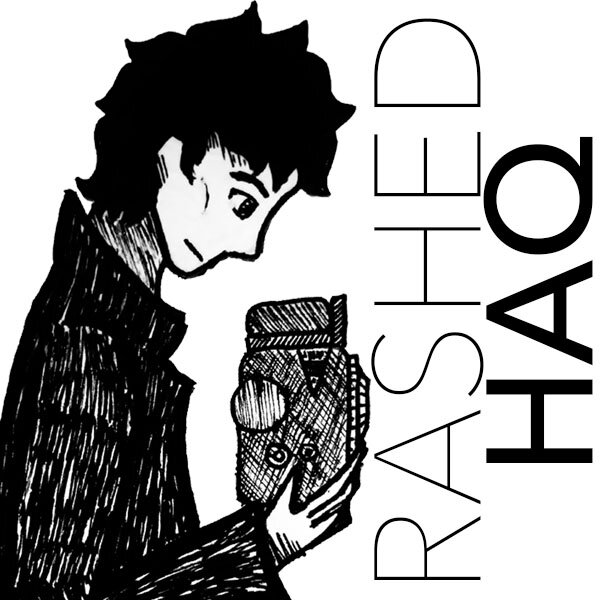/CLOUD/ Photography and Creative Coding
Barry Stone’s /CLOUD/ project is a series of 20 black and white images of clouds, inspired by Alfred Stieglitz's famous series from a hundred years ago featuring clouds, that Stieglitz called “Equivalents.” These images were Stone’s entry into creating data-driven photographs. They were taken with a digital camera and manipulated by rearranging their data with a hexadecimal editor.
/CLOUD/ #2 © Barry Stone
/CLOUD/ #6 © Barry Stone
The data of the digital photograph file “reads like a book for the image, with the top of the data corresponding to the top of the image.” Stone says “I comb through the files of my images looking for places where I hope a cool change will happen. I edit the data by replacing the hex with another part of the hex from the file.” This chance operation of rearranging and disordering results in glitches in the original image that appear “like layered collages.” Stone adds “Scanning the image, I find patterns to disrupt or amplify. I only use elements of the code already present in the file and usually employ find-and-change to create new iterations of the image. I like the fact that I am using the material of the image itself to create a new version of the image. I never really know what's going to happen until I open the image back up again in photoshop.” It is as if Stone is sculpting with the raw material which is the data behind the image.
Clouds IRL consist of minute liquid droplets and other particles suspended in the atmosphere. They play an important, often mythical, role in various cultures. Their vibratory abstractions seem as if we are looking at earth’s dreams, inspiring our own meaning-giving imaginations. Stieglitz created the first of his cloud images in 1922, with the idea of exploring what contemporary viewers might see in these patches of randomness, and perhaps reveal about themselves. A year earlier, in 1921, psychoanalyst Herman Rorschach developed the idea of using inkblots to explore the subconscious psychic contents of his patients. In the following years, many artists including Francis Picabia, Man Ray, and the Surrealists, explored this in their artwork. Robin Kelsey, professor of the history of photography at Harvard, has written, “Stieglitz searched the random play of clouds for forms that he could fashion into images corresponding to his subjective states. To put it glibly, he wanted to find his own inkblots.” He added, “As the critic Rosalind Krauss has brilliantly discussed, these pictures seem not only haphazard but also resistant to internal order.” Chance plays a pivotal role in photography, as in the “Equivalents” images, setting photography apart from many other arts such as painting and literature.
Equivalent (1923) by Alfred Stieglitz
Equivalent (1925) by Alfred Stieglitz
In today’s world, “cloud” is also a metaphor for the web2 server farms – “the cloud.” This digital cloud is also placeless and ethereal, but equally as powerful to shape our lives as the weather was to the lives of farmers a thousand years ago, because of the software code and algorithms being run on this cloud that influences most of us in some shape or form. John Maeda, one of the OG generative artists, has said that “computation has expanded both in technical capability and in sociocultural impact,” adding, “computation is an invisible, alien universe that is infinitely large and infinitesimally detailed. It’s a kind of raw material that doesn’t obey the laws of physics, and it’s what powers the internet at a level that far transcends the power of electricity.” Technology is, after all, about the human condition.
/CLOUD/ #11 © Barry Stone
/CLOUD/ #14 © Barry Stone
Stone combines these two ideas of the “cloud,” bringing together the element of chance from photography and the power of data manipulation and computation. Stone says, “for me, clouds are ephemeral structures of vapor formed by countless interactions, which are animated by our imaginations and experiences.” And he goes on to add a significant twist to his photographs – a process he calls “data bending” where he mines the abstract data in the deeper substrata of the images and moves the data around using copy/paste and find/replace. Using this process, Stone paints a world that sits between reality, imagination, and glitch. Olga Yatskevich said about Stone’s work, “What others might see as error, Stone interprets as the open space for possibilities. Digital noise and intentional distortions lead to new interpretations and variations of the original images.” Photographer and photography collector PixelPete says that Stone’s work is “a great example of an artist using creative coding to discover new depths in their work.” As I wrote in an essay recently, we will continue to see increasingly more work that combines photography and creative coding. And Stone’s work is a great example in this category with a rich connection to the history of photography.
REFERENCES
“How I Came to Photograph Clouds“ by Alfred Stieglitz. The Amateur Photographer and Photography (1923).
How to Speak Machine: Computational Thinking for the Rest of Us by John Maeda
Daily, In a Nimble Sea by Barry Stone (2017).
Are You Sure You Know What a Photograph Is? by Rashed Haq. Wired Magazine (2022).






